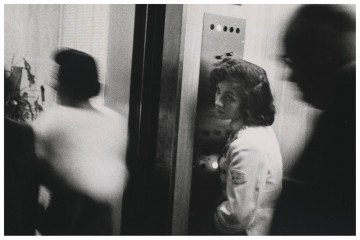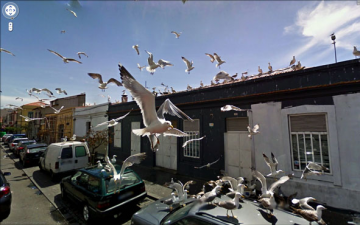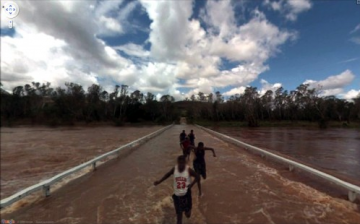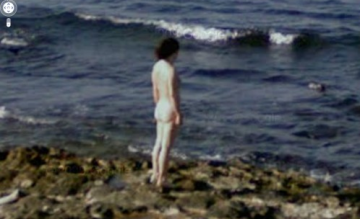In her essay “Certainties and Possibilities,” Janet Malcolm offers a brief genealogy of what she sees as a particularly American form of street photography. Malcolm starts by talking about European photographers like Henri Cartier-Bresson, André Kertész, and Brassaï, saying that these artists “pluck their pictures from the flux of street life and fix with their small cameras the fleeting moment that no brush or pencil (or even eye, sometimes) is fast enough to seize.”
Cartier-Bresson provides Malcolm with the best illustration of this mode of photography. His thoughts on “the decisive moment” provide further elaboration, this being Cartier-Bresson’s term for what he sought out, the instant at which the photographer can take a perfect picture because the action perfectly summarizes, or somehow metaphorizes, itself. In a somewhat deflating way, Malcolm argues that Cartier-Bresson’s “decisive moment” occurs at the intersection of two events: “when (1) the gesture or expression or relationship or anecdote in question is at its highest peak of intensity, and (2) the picture’s composition achieves (or retains) the appearance of a formal work of art.”
Malcolm then argues that it was Swiss-born Robert Frank, with his book The Americans, who broke this mold of street photography, and for a very specific reason. “Frank’s important discovery… was that you can’t get (2) in this country [America], and you shouldn’t try. This country is too messy and ugly—there are too many cars, signs, billboards, plastic baby strollers, women in pink curlers, garbage bags, high-rise buildings.” A photograph taken in this context cannot obey classical rules of composition, and Frank’s genius, in Malcolm’s system, was to embrace this “disorder” and “vulgarity” and to seek out the highest peaks of intensity by impulse, with a blatant disregard for giving his pictures the appearance of a formal work of art. This lent his photographs an aura of blunt and brutal facticity that has often been imitated and exaggerated, not least by Frank himself in his later Polaroids.
It’s interesting to think of Malcolm’s arguments in the context of globalization. The elements of America that made it immune to the Cartier-Bresson feeling of stolen elegance—particularly cars, signs, and billboards—have metastasized (a process that was already well underway when Malcolm wrote the essay, in 1975). One wonders, too, if the growth of spectacle has impeded the process of searching out Malcolm’s (1). Finding the “highest peak of intensity” of a “gesture or expression or relationship or anecdote” might be difficult in areas where everything is perpetually raised to a high peak of intensity. What would a photographer in Times Square or Shibuya Crossing or Piccadilly Circus look for, exactly? How would she know what was important?
I would argue this is some of what’s at stake in Jon Rafman’s incredible project, “The Nine Eyes of Google Street View.”
Rafman has culled from Google’s mapping program an enormous and diverse selection of images, creating an archive of art objects from a database of information. There’s a way in which Rafman intensifies the elements of Frank’s photographs to which Malcolm is attuned. Where a post-Frank artist like Gary Winogrand, in the words of Malcolm, “[compounded] the chaos of his pictures by taking them at radical angles,” Rafman’s angles are, in a sense, more radical because more arbitrary.
But on a different level, Rafman is actually recouping the showmanship of “the decisive moment.” His pictures wouldn’t thrill us if they looked like Winogrand’s, or even Frank’s. They thrill us because they look like Cartier-Bresson’s and Kertész’s and Brassaï’s. They’re so compelling because they seem to be taken when (1) the gesture or expression or relationship or anecdote in question is at its highest peak of intensity, and (2) the picture’s composition achieves (or retains) the appearance of a formal work of art. Our knowledge of Rafman’s process heightens our sense of every moment’s decisiveness, even when the stills lack the formal rigour of a Cartier-Bresson.
Frank and Winogrand were trying to find forms that could deal with contemporary life. Their approach tried not to try to beautify, but to reflect. Google Street View, the program, is in some ways an embodiment of the things about contemporary life that Frank and Winogrand were dealing with: it’s automated and pragmatically unaesthetic. But Rafman finds that it, of its own accord, occasionally beautifies. Frank and Winogrand embraced accident, hoping that in doing so their work could honestly portray the machine age; Rafman has discovered that machines themselves accidentally portray what some might take to be artifice, but who’s to say they’re not being honest?









Pingback: The Best of Google Street View | That Was Random .com - Sharing Random Videos, Images and More. Sharing Random Stuff from Present to Nostalgic